Velvet Revolution
| Part of the Revolutions of 1989 | |
.jpg) Demonstration of 25 November 1989 in Prague. | |
| Date |
17 November 1989–29 December 1989 (1 month, 1 week and 5 days) |
|---|---|
| Location | Czechoslovakia (now Czech Republic & Slovakia) |
| Participants | Czechs and Slovaks |
| Outcome |
|
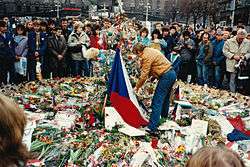
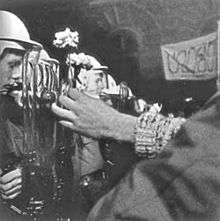
The Velvet Revolution (Czech: sametová revoluce) or Gentle Revolution (Slovak: nežná revolúcia) was a non-violent transition of power in what was then Czechoslovakia. The period of upheaval and transition took place from November 17 to December 29, 1989. Popular demonstrations against the one-party government of the Communist Party of Czechoslovakia combined students and older dissidents. The end result was the end of 41 years of one-party rule in Czechoslovakia, and the subsequent dismantling of the planned economy and conversion to a parliamentary republic.[1]
On November 17, 1989 (International Students' Day), riot police suppressed a student demonstration in Prague.[2] That event sparked a series of demonstrations from November 19 to late December. By November 20, the number of protesters assembled in Prague had grown from 200,000 the previous day to an estimated 500,000. A two-hour general strike involving all citizens of Czechoslovakia was held on November 27. On November 24, the entire top leadership of the Communist Party, including General Secretary Miloš Jakeš, resigned.
In response to the collapse of other Warsaw Pact governments and the increasing street protests, the Communist Party of Czechoslovakia announced on November 28 that it would relinquish power and dismantle the one-party state. Two days later, the legislature formally deleted the sections of the Constitution giving the Communists a monopoly of power. Barbed wire and other obstructions were removed from the border with West Germany and Austria in early December. On December 10, President Gustáv Husák appointed the first largely non-communist government in Czechoslovakia since 1948, and resigned. Alexander Dubček was elected speaker of the federal parliament on December 28 and Václav Havel the President of Czechoslovakia on December 29, 1989.
In June 1990, Czechoslovakia held its first democratic elections since 1946.
The term Velvet Revolution was coined by Rita Klímová, the dissidents' English translator[3] who later became the ambassador to the United States.[4] The term was used internationally to describe the revolution, although the Czechs also used the term internally. After the dissolution of Czechoslovakia in 1993, Slovakia used the term Gentle Revolution, the term that Slovaks used for the revolution from the beginning. The Czech Republic continues to refer to the event as the Velvet Revolution.
Prior to the revolution
Part of a series on the |
||||||||||||||||
|---|---|---|---|---|---|---|---|---|---|---|---|---|---|---|---|---|
| History of Czechoslovakia | ||||||||||||||||
|
||||||||||||||||
The Communist Party seized power on February 25, 1948. No official opposition parties operated thereafter. Dissidents (notably Charter 77) published home-made periodicals (samizdat), but they faced persecution by the secret police. Thus, the general public did not openly support the dissidents for fear of dismissal from work or school. A writer or filmmaker could have his/her books or films banned for a "negative attitude towards the socialist regime". This blacklisting included children of former entrepreneurs or non-Communist politicians, having family members living in the West, having supported Alexander Dubček during the Prague Spring, opposing Soviet military occupation, promoting religion, boycotting (rigged) parliamentary elections or signing Charter 77 or associating with those who did. These rules were easy to enforce, as all schools, media and businesses belonged to the state. They were under direct supervision and often were used as accusatory weapons against rivals.
The nature of blacklisting changed gradually after the introduction of Mikhail Gorbachev's policies of Glasnost (openness) and Perestroika (restructuring) in 1985. The Czechoslovak Communist leadership verbally supported Perestroika, but made few changes. Speaking about the Prague Spring of 1968 was taboo. The first anti-government demonstrations occurred in 1988 (the Candle Demonstration, for example) and 1989, but these were dispersed and participants were repressed by the police.
By the late 1980s, discontent with living standards and economic inadequacy gave way to popular support for economic reform. Citizens began to challenge the system more openly. By 1989, citizens who had been complacent were willing to openly express their discontent with the regime. Numerous important figures as well as common workers signed petitions in support of Václav Havel during his 1989 imprisonment. Reform-minded attitudes were also reflected by the many individuals who signed a petition that circulated in the summer of 1989 calling for the end of censorship and the beginning of drastic political reform.[5]
The immediate impetus for the revolution came from developments in neighboring countries and in the Czechoslovak capital. Since August, East German citizens had occupied the West German Embassy in Prague and demanded exile to West Germany. In the days following November 3, thousands of East Germans left Prague by train to West Germany. On November 9, the Berlin Wall fell, removing the need for the detour.
By November 16, many of Czechoslovakia's neighbours were beginning to shed authoritarian rule. The citizens of Czechoslovakia watched these events on TV through both foreign and domestic signals. The Soviet Union also supported a change in the ruling elite of Czechoslovakia, although it did not anticipate the overthrow of the Communist regime.
Chronology
November 16
On the eve of International Students Day (the 50th anniversary death of Jan Opletal, a Czech student who was killed by the Nazis), Slovak high school and university students organized a peaceful demonstration in the center of Bratislava. The Communist Party of Slovakia had expected trouble, and the mere fact that the demonstration was organised was viewed as a problem by the Party. Armed forces were put on alert before the demonstration. In the end, however, the students moved through the city peacefully and sent a delegation to the Slovak Ministry of Education to discuss their demands.
November 17
New movements led by Václav Havel surfaced, invoking the idea of a united society where the state would politically restructure.[6] The Socialist Union of Youth (SSM/SZM, proxy of Communist Party of Czechoslovakia) organized a mass demonstration to commemorate International Students Day and the fiftieth anniversary of the murder of students by the Nazi government.[6]
Most members of SSM had privately been in opposition to the Communist leadership, but had been afraid of speaking up for fear of persecution. This demonstration gave average students an opportunity to join others and express their opinions. By 16:00, about 15,000 people had joined the demonstration. They walked (per the strategy of founders of Stuha movement, Jiří Dienstbier and Šimon Pánek) to Karel Hynek Mácha's grave at Vyšehrad Cemetery and — after the official end of the march — continued into downtown Prague,[7] carrying banners and chanting anti-Communist slogans. At about 19:30, the demonstrators were stopped by a cordon of riot police at Národní Street. They blocked all escape routes and attacked the students. Once all the protesters dispersed, one of the participants— secret police agent Ludvík Zifčák — was lying on the street. Zifčák was not physically hurt or pretending to be dead; he had been overcome by emotion. Policemen carried his motionless body to an ambulance. The atmosphere of fear and hopelessness gave birth to a hoax about the dead student. This hoax was made up by Drahomíra Dražská, while she awaited treatment later after she was hurt during the riot. Dražská worked at the college and shared her hoax with several people next day, including the wife of journalist Petr Uhl, a correspondent for Radio Free Europe. This incident mobilised the people and triggered the revolution. That same evening, students and theatre actors agreed to go on strike.
November 18
Two students visited Prime Minister Ladislav Adamec at his private residence and described to him what had happened on Národní Street. The strike at the Realistic Theater was declared and other theaters quickly followed. The theaters opened their stages only for public discussions. At the initiative of students from the Academy of Performing Arts in Prague, the students in Prague went on strike. This strike was joined by university students throughout Czechoslovakia. Theater employees and actors in Prague supported the strike. Instead of going on stage, actors read a proclamation by the students and artists to the audience, that called for a general strike on November 27. Home-made posters and proclamations were posted. As all media (radio, TV, newspapers) were strictly controlled by the Communist Party (see Mass media in Communist Czechoslovakia), this was the only way to spread the message. In the evening, Radio Free Europe reported that a student (named as Martin Šmíd) was killed by the police during the previous day's demonstration. Although the report was false, it heightened the feeling of crisis, and persuaded some hesitant citizens to overcome their fear and join the protests.[6]
November 19
Theatres in Bratislava, Brno, Ostrava and other towns went on strike. Members of artistic and literary associations as well as organizations and institutions joined the strike. Members of a civic initiative met with the Prime Minister, who told them that he had twice been prohibited from resigning his post and that change requires mass demonstrations like those in East Germany (some 250,000 students). He asked them to keep the number of "casualties" during the expected change to a minimum. About 500 Slovak artists, scientists and leaders met at the Art Forum (Umelecká beseda) in Bratislava at 17:00. They denounced the attack against the students in Prague on November 17 and formed Public Against Violence, which would become the leading force behind the opposition movement in Slovakia. Its founding members included Milan Kňažko, Ján Budaj and others.
Actors and members of the audience in a Prague theatre, together with Václav Havel and other prominent members of Charter 77 and other dissident organizations, established the Civic Forum (Občanské fórum — an equivalent of the Slovak Public Against Violence for the territory of the Czech Republic) as a mass popular movement for reforms, at 22:00. They called for the dismissal of top officials responsible for the violence, and an independent investigation of the incident and the release of all political prisoners. College students went on strike. On television, government officials called for peace and a return to the city's normal business. and an interview with Martin Šmíd was broadcast to persuade the public that nobody had been killed; the quality of the recording was low and rumors continued. It would take several more days to confirm that nobody had been killed and, by then, the revolution had gained further momentum.
The leaders of the Democratic Initiative presented several demands, including the resignation of the government, effective November 25, and the formation of a temporary government composed of noncompromised members of the current government.[8]
November 20
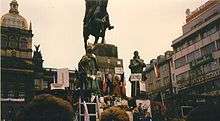
Students and theater went on "permanent" strike. Police stopped a demonstration from continuing toward Prague Castle, which would have entered the striking theaters.[6] Civic Forum representatives negotiated unofficially with Adamec without Havel. Adamec was sympathetic to the students' demands. However, he was outvoted in a special cabinet meeting the same day. The government, in an official statement, made no concessions. Civic Forum added a demand: the abolition of the "ruling position" of the Communist Party from the Constitution. Non-Communist newspapers published information that contradicted the Communist interpretation. The first mass demonstration in Prague (100,000 people) and the first demonstrations in Bratislava occurred.
November 21
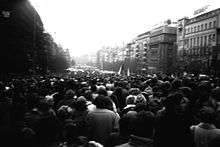
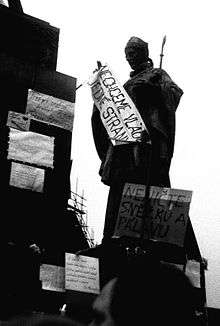
The first official meeting of the Civic Forum with the Prime Minister takes place. The Prime Minister agrees to personally guarantee that no violence would be used against the people; however he would "protect socialism, about which no discussion is possible".[6] An organized mass demonstration takes place in Wenceslas Square in central Prague (demonstrations recur there throughout the following days). Actors and students travel to factories inside and outside Prague to gain support for their colleagues in other cities.
A mass demonstration erupts in Hviezdoslav Square in downtown Bratislava (in the following days, it moves to the Square of the Slovak National Uprising). The students present demands and ask the people to participate in the general strike planned for Monday, November 27. A separate demonstration demands the release of the political prisoner Ján Čarnogurský (later Prime Minister of Slovakia) in front of the Palace of Justice. Alexander Dubček addresses this demonstration—his first appearance during the Velvet Revolution. As a result, Čarnogurský is released on November 23. Further demonstrations follow in all major cities of Czechoslovakia.
Cardinal František Tomášek, the Catholic primate of the Bohemian lands, declares his support for the students and issues a declaration criticizing the current government's policies. For the first time during the Velvet Revolution, the "radical" demand to abolish the article of the Constitution establishing the "leading role" of the Communist Party is expressed by Ľubomír Feldek at a meeting of Public Against Violence.
In the evening, Miloš Jakeš, the chairman of the Communist Party of Czechoslovakia, gives a special address on Federal Television. He says that order must be preserved, that socialism is the only alternative for Czechoslovakia and criticizes protest groups. Government officials, especially the Head of the Communist Party Miloš Jakeš, keep their hard-line position. During the night, they had summoned 4,000 members of the "People's Militias" (Lidové milice, a paramilitary organization subordinated directly to the Communist Party) to Prague to crush the protests, but call them off.
November 22
Civic Forum announces a two-hour general strike for Monday November 27. The first live reports from the demonstration in Wenceslas Square appear on Federal Television (and are quickly cut off, after one of the participants denounced the present government in favor of Alexander Dubček). Striking students force the representatives of the Slovak government and of the Communist Party of Slovakia to participate in a dialogue, in which the official representatives are immediately put on the defensive. Employees of the Slovak section of the Federal Television require the leaders of the Federal Television to provide true information on the events in the country; otherwise they would initiate a strike of TV employees. Uncensored live reports from demonstrations in Bratislava begin.
November 23
Evening news shows factory workers heckling Miroslav Štěpán, the Prague Communist Secretary. The military inform the Communist leadership of its readiness to act (ultimately, it was never used against demonstrators). The military and the Ministry of Defense were preparing for actions against the opposition. Immediately after the meeting, however, the Minister of Defense delivers a TV address, in which he says that the army would never undertake action against the people and calls for an end to demonstrations.
November 24
The entire Presidium, including General Secretary Miloš Jakeš, resigns. Karel Urbánek, a more moderate Communist, is named General Secretary. Federal Television shows pictures from November 17 for the first time and presents the first television address of Václav Havel, dealing mostly with the planned general strike.[9] Czechoslovak TV and Radio announce that they will join the general strike. A discussion with representatives of the opposition is broadcast by the Slovak section of Federal Television.[10] Opposition is represented by Ján Budaj, Fedor Gál and Vladimír Ondruš. Communists are represented by Štefan Chudoba (director of Bratislava automotive company), Peter Weiss (secretary of the Institute of Marx-Leninism of the Communist party of Slovakia) and the director of Steelworks Kosice. It was the first free discussion on Czechoslovak television since its beginning. As a result, the editorial staff of Slovak newspapers start to join the opposition.
November 25
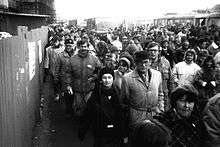
The new Communist leadership holds a press conference. It includes Miroslav Štěpán, while excluding Ladislav Adamec and does not address demonstrators' demands. Later that day, Štěpán resigns as Prague Secretary. The number of participants in the regular anti-government demonstration in Prague-Letná reach an estimated 800,000 people. Demonstrations in Bratislava peak at around 100,000 participants.
November 26
Prime Minister Adamec met with Havel for the first time. The editorial staff of Slovakia's Pravda, the central newspaper of the Communist Party of Slovakia, join the opposition.
November 27
.jpg)
A successful two-hour general strike led by the civic movements strengthens what were at first a set of moderate demands into cries for a new government.[8] It took place throughout the country between 12:00 and 14:00, supported by a reported 75% of the population. The Ministry of Culture releases anti-Communist literature for public checkouts in libraries, effectively ending decades of censorship. Civic Forum demonstrates its capacity to disrupt the political order and thereby establish itself as the legitimate voice of the nation in negotiations with the state.[6] The civic movements mobilize support for the general strike.[8]
November 29
The Federal Assembly deletes the provision in the constitution referring to the "leading role" of the Communist Party, officially ending Communist rule in Czechoslovakia.
December 10
President Gustáv Husák swears in the first government in 41 years that is not dominated by the Communist Party. He resigns shortly afterward.
Aftermath
.jpg)
The victory of the revolution was topped off by the election of rebel playwright and human rights activist Václav Havel as President of Czechoslovakia on December 29, 1989. Free elections held in June 1990 legitimized this government and set the stage for addressing the remnants of the Communist party’s power and the legacy of the Communist period. The main threat to political stability and the success of Czechoslovakia’s shift to democracy appeared likely to come from ethnic conflicts between the Czechs and the Slovaks, which resurfaced in the post-Communist period.[11] However, there was a general consensus to move toward a market economy, so in early 1990, the President and his top economic advisors decided to liberalize prices, push de-monopolization and privatize the economy. The outcome of the transition to democracy and a market economy would depend on the extent to which developments outside the country facilitated or hindered the process of change.[12]
Open questions
Conspiracy theorists tried to portray the revolution as a plot by the StB, KGB, reformists among party members or Mikhail Gorbachev. According to these theories, the Communist Party only transformed its power into other, less visible forms and still controls society. Belief in such theories has decreased, but well-known individuals such as KGB defector Anatoliy Golitsyn and Czech dissident (and former friend of Havel) Petr Cibulka still contend that the 1989 Velvet Revolution in Czechoslovakia was staged by the Communist StB secret police.
The most contentious points were:
- It is not clear to what extent events were spontaneous or orchestrated by the secret police. For example, the incident with the "dead student" was staged by secret police provocateur Ludvík Zifčák and assisted by other secret agents (those who took him to the hospital and initially disseminated the rumor). Zifčák is currently a chairman of the "Communist Party of Czechoslovakia", a non-parliamentary group aiming to restore a Communist regime, with popular support below 1%, and rejects all inquiries relating to his role in the revolution.
- The Army and People's Militia were ready to attack the demonstrators, but did not receive orders to do so.
- Secret police carried out surveillance on the leaders of the revolution and had the ability to arrest them. However, they did not do so and let the revolution proceed.
- A Soviet military advisor was present in the control center of the police force, which attacked the demonstrators on November 17. Supposedly, he did not intervene, but his role is unclear.
According the former communist leader Milos Jakes, the entire velvet revolution was orchestrated by StB in cooperation with KGB and other centers of power in the state, the students and dissidents played only secondary role in the transition of power.[13]
The character and consequences of the events were partially addressed by Miroslav Dolejsi in his Analysa 17 of 17 November 1989 outlined the broader context.[14]
Explanations include a possible split between different factions of the Communist leadership (namely, reform Communists anxious to replace those afraid of any change), the collapse of communism elsewhere and the absence of the military power of the Soviet Union.
External factors
The events of November 1989 confirmed that outside factors were significant catalysts for the downfall of Communism in Czechoslovakia. Therefore, the transformations in Poland and Hungary and the collapse of the regime in East Germany, both of which could be traced to the new attitude of the Soviets toward East Europe, encouraged Czechs and Slovaks to take to the streets to win their freedom. However, national factors, including the economic and political crisis and the actions of groups and individuals working towards a transformation, destabilized support for the system.[12]
Pace of change
The state’s reaction to the strikes demonstrated that while global isolation produced pressures for political, social, and economic change, the events that followed could not be predetermined. Hardly anyone thought that the state could collapse so quickly. Striking students and theaters did not seem likely to intimidate a state that was able to repress any sort of demonstration. This "popular" phase of the revolution, was followed by victories made possible by the Civic Forum’s successful mobilization for the general strike on November 27, which established its legitimacy to speak for the nation in negotiations with the state.[6] The mass demonstrations that followed November 17 led to the resignation of the Party leadership of Milos Jakes, the removal of the Party from its leading role and the creation of the non-Communist government. Supporters of the revolution had to take instant responsibility for running the government, in addition to establishing essential reforms in political organization and values, economic structure and policies and foreign policy.[15]
Jingled keys
One element of the demonstrations of the Velvet Revolution was the jingling of keys to signify support. The practice had a double meaning—it symbolized the unlocking of doors[16][17] and was the demonstrators' way of telling the Communists, "Goodbye, it's time to go home".[3]
A commemorative 2 Euro coin was issued by Slovakia on November 17, 2009, to mark the twentieth anniversary. The coin depicts a bell with a key adjoining the clapper.[18] Ursula K. Le Guin wrote a short story, "Unlocking the Air", in which the jingling of keys played a central role in the liberation of a fictional country called Orsinia.
See also
- Civic Forum and Public Against Violence (political movements that played major role in the revolution)
- Civil resistance
- Dissolution of Czechoslovakia (peaceful dissolution of Czechoslovakia few years later)
- Eastern Bloc emigration and defection
- Orange Revolution
- People Power Revolution
- Revolutions of 1989
- Rose Revolution
References
- ↑ "RP's History Online - Velvet Revolution". Archiv.radio.cz. Retrieved 2013-01-19.
- ↑ "Velvet Revoe Czechoslovakia". Prague-life.com. Retrieved 2013-11-24.
- 1 2 Sebetsyen, Victor (2009). Revolution 1989: The Fall of the Soviet Empire. New York City: Pantheon Books. ISBN 0-375-42532-2.
- ↑ Nelson, Lars-Erik. New Czechoslovakian Leaders Are As Stunned As Their People. New York Daily News, 1990-02-21.
- ↑ Wolchik, Sharon L. “Czechoslovakia's ‘Velvet Revolution.’” 1990. Current History. 89:413-416,435-437. Retrieved March 11, 2009
- 1 2 3 4 5 6 7 Glenn, John K. “Competing Challengers and Contested Outcomes to State Breakdown: The Velvet Revolution in Czechoslovakia”. September 1999. Social Forces. 78:187-211. Retrieved March 11, 2009.
- ↑ "Sametová revoluce - trasa demonstrace: TOTALITA". Totalita.cz. Retrieved 2013-11-24.
- 1 2 3 Shepherd, Robin H.E. (2000). Czechoslovakia" The Velvet Revolution and Beyond. New York, NY: St. Martin's Press, Inc.
- ↑ Prvé vysielanie záberov zo 17. novembra 1989 on YouTube Federal Television showed pictures from November 17 for the first time transmitted one week later on Nov 24.
- ↑ Stanislav Háber: Ako vzniklo prvé Štúdio dialóg "How the first Studio Dialogue was created", Slovak v exile, 17.11.2004
- ↑ Holy, Ladislav (1996). The Little Czech and The Great Czech Nation: National identity and the post-communist transformation of society. Cambridge, Great Britain: Cambride University Press.
- 1 2 Wolchik, Sharon L. “Czechoslovakia's ‘Velvet Revolution.’” 1990. Current History. 89:413-416,435-437. Retrieved March 11, 2009.
- ↑ Benešová, Hana (2014-10-24). "Miloš Jakeš: Listopad zinscenovala StB, disidenti na tom zásluhu nemají". Reflex (magazine) (in Czech). Retrieved 2016-05-06.
- ↑ "Dolejsi Analysis-1". Jrnyquist.com. Retrieved 2013-11-24.
- ↑ Wolchik, Sharon L. “Czechoslovakia's ‘Velvet Revolution.’” 1990. Current History. 89:413-416,435-437. Retrieved March 11, 2009 (h)
- ↑ "Havel at Columbia: The Velvet Revolution". Havel.columbia.edu. Retrieved 2013-01-19.
- ↑ "Today, at exactly noon in Prague, people flooded into the streets around Wenceslas Square, the central shopping thoroughfare, rattling key chains and tinkling tiny bells. The jingling of keys, acts symbolizing the opening of hitherto locked doors, has become a common gesture in the wave of demonstrations.... On Jungmanova Square, Mr. Havel himself stood beaming broadly on the balcony of a building.... He lustily jingled a bunch of keys." John Tagliabue, "Upheaval in the East; From All Czechoslovakia, a Joyful Noise," The New York Times, Dec. 12, 1989.
- ↑ "Slovakia 2009 2 Euro Comm.- New image". Ibiblio.org. Retrieved 2013-01-19.
- Notes
- Kukral, Michael Andrew. Prague 1989: Theater of Revolution. New York: Columbia University Press. 1997. ISBN 0-88033-369-3.
- Glenn, John K. “Competing Challengers and Contested Outcomes to State Breakdown: The Velvet Revolution in Czechoslovakia”. September 1999. Social Forces. 78:187-211. Retrieved March 11, 2009.
- Holy, Ladislav (1996). The Little Czech and The Great Czech Nation: National identity and the post-communist transformation of society. Cambridge, Great Britain: Cambride University Press.
- Shepherd, Robin H.E. (2000). Czechoslovakia" The Velvet Revolution and Beyond. New York, NY: St. Martin's Press, Inc..
- Wolchik, Sharon L. “Czechoslovakia's ‘Velvet Revolution.’” 1990. Current History. 89:413-416,435-437. Retrieved March 11, 2009.
Further reading
- Kukral, Michael Andrew. Prague 1989: Theater of Revolution. New York: Columbia University Press. 1997. ISBN 0-88033-369-3.
- Timothy Garton Ash, We the People: The Revolution of ’89, Witnessed in Warsaw, Budapest, Berlin and Prague (Cambridge, 1990).
- Marek Benda, Martin Benda, Martin Klíma, Pavel Dobrovský, Monika Pajerová, and Šimon Pánek, Studenti psali revoluci (Students wrote the revolution -in Czech). Prague: Univerzum, 1990. ISBN 80-85207-02-8.
- Tauchen, Jaromír - Schelle, Karel etc.: The Process of Democratization of Law in the Czech Republic (1989–2009). Rincon (USA), The American Institute for Central European Legal Studies 2009. 204 pp. ISBN 978-0-615-31580-5.
- Williams, Kieran, 'Civil Resistance in Czechoslovakia: From Soviet Invasion to "Velvet Revolution", 1968–89,' in Adam Roberts and Timothy Garton Ash (eds.), Civil Resistance and Power Politics: The Experience of Non-violent Action from Gandhi to the Present. Oxford & New York: Oxford University Press, 2009. ISBN 978-0-19-955201-6.
External links
| Wikimedia Commons has media related to Velvet Revolution. |
- Velvet Revolution on web project of Institute of Contemporary History, Prague Detailed documentation, textual and visual, of the Velvet Revolution partly in English.
- The Velvet Philosophical Revolution, City Journal, Winter 2010
- Velvet Revolution on totalita.cz Detailed day-to-day history with key documents quoted (in Czech language only). Shortened version was used as a source for Chronology above.
- Velvet Revolution on Prague-life A shortened version of the Velvet Revolution.
- In the footsteps of November 17 - Czech.cz
- After the Velvet, the Existential Revolution? dialogue between Václav Havel and Adam Michnik, English, salon.eu.sk, November 2008
- The Velvet Oratorio An oratorio based on the events of the Velvet Revolution
- Velvet Revolution Diary English translation of an authentic diary of a student participating in the revolution plus scans of US articles from that time